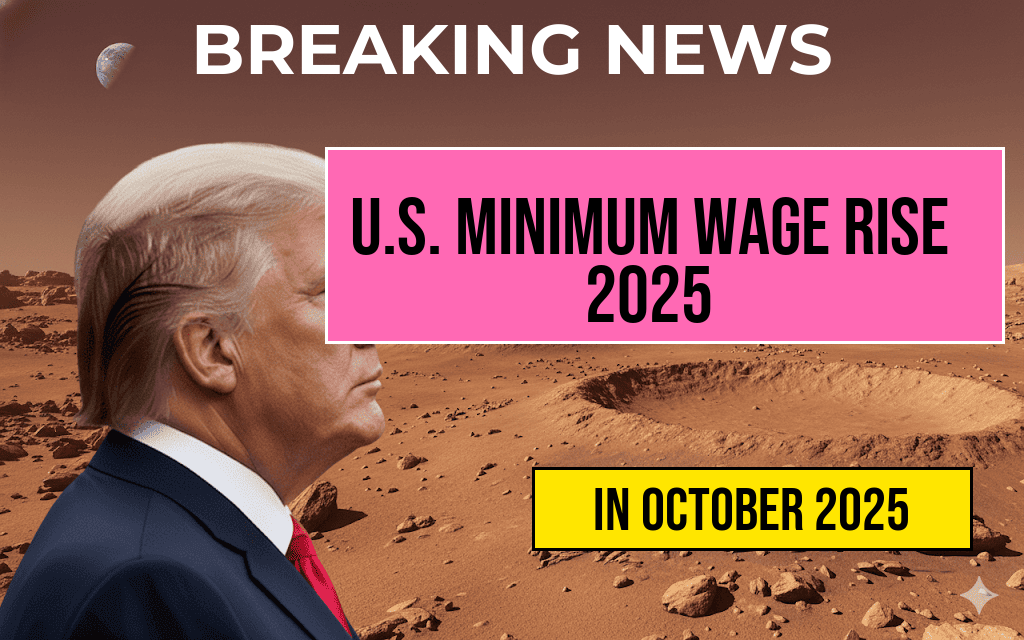The United States is implementing an updated federal minimum wage effective October 4, 2024, with new hourly pay rates scheduled for 2025. This adjustment follows months of policy discussions and legislative updates aimed at addressing inflation and improving income levels for low-wage workers across the country. While some states and localities set their own minimum wages, this federal increase sets a baseline that will impact millions of employees nationwide, particularly those in sectors like retail, hospitality, and healthcare. The new rates reflect a modest increase from the previous year, aligning with economic forecasts and labor market trends. Employers are now preparing for compliance, and workers are expected to see a boost in their earnings starting this fall, with further adjustments anticipated for 2025.
Federal Minimum Wage Increase Details for 2025
New Hourly Pay Rates and Effective Date
| Workplace Type | Current Rate (2024) | New Rate (Effective October 4, 2024) |
|---|---|---|
| Federal contractors and subcontractors | $12.50 | $13.75 |
| Private sector employees (non-exempt) | $10.50 | $11.75 |
| Applies to workers covered under FLSA | $10.50 | $11.75 |
The increase, effective October 4, 2024, is part of a federal policy aimed at gradually raising wages to better reflect inflation and cost-of-living changes. The Department of Labor announced that the adjusted rates will be applicable to workers covered under the Fair Labor Standards Act (FLSA), including many federal contractors and employees in states that follow federal guidelines. For workers in states with their own minimum wage laws, the state rate remains the legal minimum, but the federal minimum acts as a floor where applicable.
Impacts on Employers and Workers
Employer Preparations and Compliance
Businesses across the country are updating payroll systems and revising staffing budgets to accommodate the new wage standards. Larger corporations with nationwide operations are particularly attentive to ensuring compliance in all jurisdictions, especially in states with higher minimum wages. Small businesses, however, may face challenges balancing increased labor costs with profitability. Industry associations have urged federal and state authorities to provide guidance and support during this transition to minimize disruptions.
Expected Benefits for Workers
Analysts project that the wage increase could elevate earnings for approximately 3 million workers, especially those in entry-level positions or part-time roles. Many employees are expected to experience a tangible boost in disposable income, which could influence spending patterns and economic activity. Advocates argue that higher wages contribute to reduced reliance on social safety net programs and promote economic mobility, while opponents caution about potential impacts on employment levels and prices.
Broader Economic Context and Future Outlook
Inflation and Legislative Trends
The recent adjustment aligns with broader economic trends, including sustained inflation rates and efforts by policymakers to address income inequality. The Biden administration has emphasized the importance of fair wages, with some proposals advocating for a $15 minimum wage nationwide—though legislative hurdles remain. The current increase is viewed as a step toward more comprehensive wage reforms, with discussions ongoing in Congress about potential future escalations.
State and Local Variations
While the federal minimum wage sets a baseline, many states and cities have already established higher minimum wages. California, New York, and Washington, for instance, have minimum wages exceeding $15 per hour in some regions. These local policies often reflect the higher living costs in those areas and can lead to wage disparities across the country. Workers in jurisdictions with higher rates will see no change from the federal update, but the federal increase influences employers operating in multiple states or under federal contracts.
Resources for Employers and Employees
- U.S. Department of Labor – Minimum Wage
- Wikipedia – Minimum Wage in the United States
- Forbes – Impact of 2025 Federal Wage Increase
Frequently Asked Questions
What is the new minimum wage rate effective October 4, 2025?
The U.S. minimum wage has increased to an updated hourly pay rate, effective October 4, 2025. The specific rate varies by state and locality, with many areas seeing an increase to ensure fair compensation for workers.
Which states or cities have increased their minimum wage for 2025?
Several states and cities across the U.S. have announced minimum wage increases for 2025. To see if your area is affected, check local government updates, as some regions set their own rates higher than the federal minimum.
How does the 2025 minimum wage increase impact employers?
Employers are required to adjust their payroll to meet or exceed the new minimum wage rates effective October 4, 2025. This may impact labor costs and could influence pricing, staffing, and budgeting decisions.
Are there any exceptions or special cases to the new minimum wage?
Yes, certain employee classifications, such as tipped workers, minors, or specific industries, may have different minimum wage requirements. Always consult local or federal regulations for specific exceptions.
What should workers do if they are paid below the new minimum wage?
If you believe you are earning less than the updated minimum wage effective October 4, 2025, you should contact your employer or local labor department to resolve the issue. Workers have the right to receive at least the minimum wage as mandated by law.

Leave a Reply